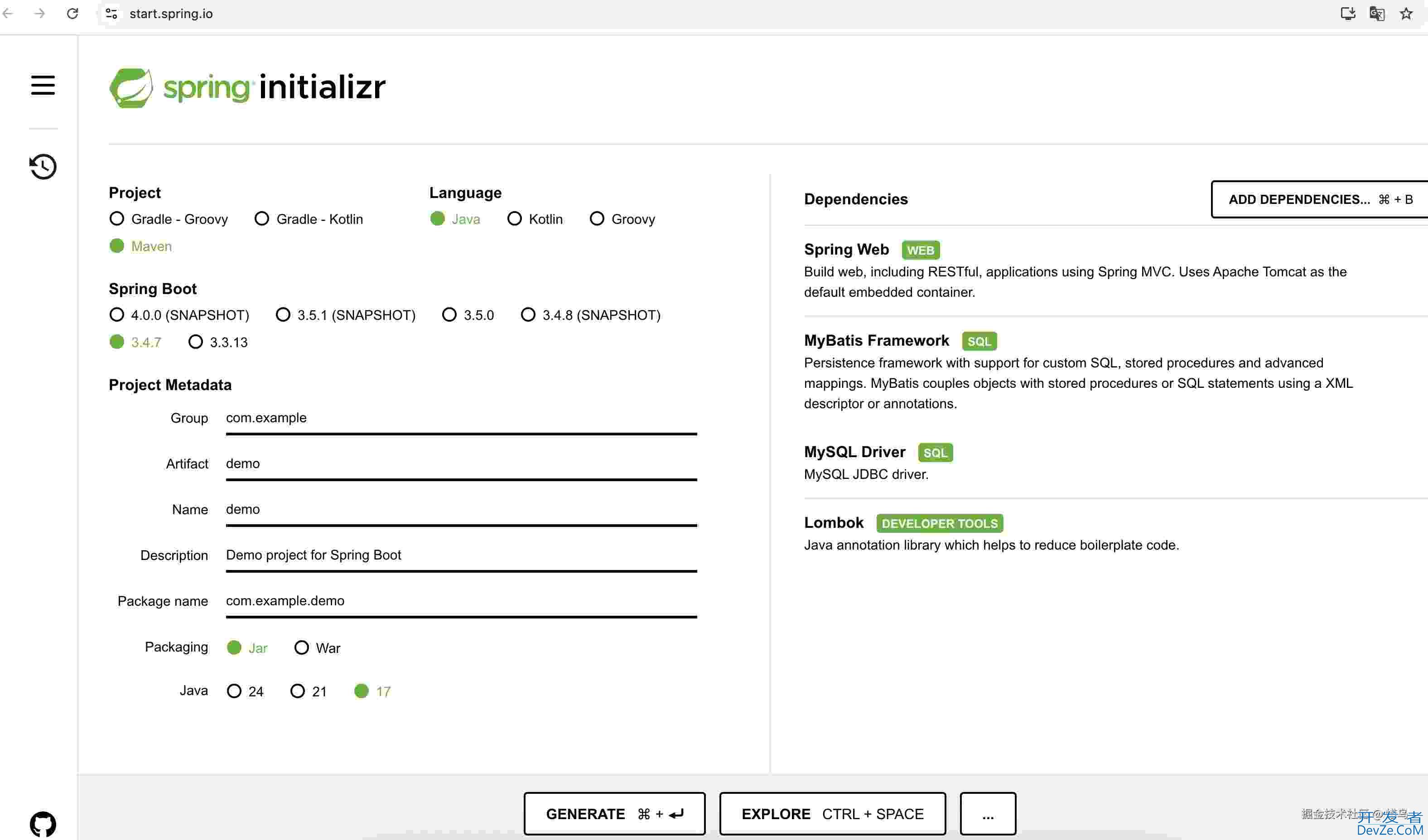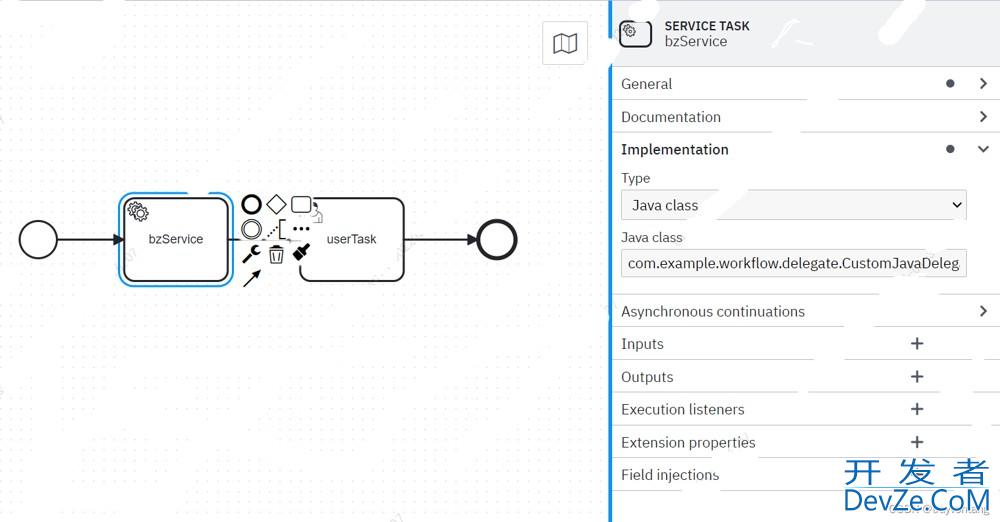SpringBoot使用MyBatis Generator生成动态SQL的详细步骤
目录
- 概述
- 详细步骤
- 一、创建Spring Boot项目并添加依赖
- 二、编写generatorConfig.XML配置文件
- 三、配置application.properties
- 四、运行MyBATis Generator生成代码
- 五、在Spring Boot中使用生成的Mapper
- 六、MyBatis Dynamic SQL 生成代码的特点
- 七、注意事项
- 八、总结
概述
我们将在Spring Boot项目中集成MyBatis Generator,并配置其生成MyBatis Dynamic SQL风格的代码。 MyBatis Dynamic SQL是MyBatis 3的一个特性,它允许使用Java API构建动态SQL查询,避免编写XML或使用Example类。
MyBatis Dynamic SQL 核心优势
- 类型安全:所有列引用都是类型安全的
- 流畅的API:链式调用构建查询
- 动态SQL:自然处理条件逻辑
- 无XML:避免XML配置的繁琐
- IDE支持:自动补全和类型检查
步骤概述:
- 创建Spring Boot项目,添加必要的依赖(包括MyBatis Spring Boot Starter、数据库驱动、MyBatis Generator等)。
- 配置MyBatis Generator(通过Maven插件方式)。
- 编写generatorConfig.xml配置文件,指定生成Dynamic SQL风格的代码。
- 运行MyBatis Generator生成代码。
- 在Spring Boot中配置MyBatis,使用生成的Mapper。
详细步骤
一、创建Spring Boot项目并添加依赖
使用Spring Initializr创建一个新项目,选择以下依赖:
- Spring Web (如果构建Web应用)
- MyBatis Framework
- mysql Driver (以MySQL为例,或者根据你的数据库选择)

然后在pom.xml中添加MyBatis G编程客栈enerator Maven插件以及MyBatis Dynamic SQL依赖:
<dependencies>
<!-- Spring Boot Starter -->
<dependency>
<groupId>org.springframework.boot</groupId>
<artifactId>spring-boot-starter-web</artifactId>
</dependency>
<!-- MyBatis Spring Boot Starter -->
<dependency>
<groupId>org.mybatis.spring.boot</groupId>
<artifactId>mybatis-spring-boot-starter</artifactId>
<version>3.0.3</version>
</dependency>
<!-- MySQL 驱动 -->
<dependency>
<groupId>com.mysql</groupId>
<artifactId>mysql-connector-j</artifactId>
<scope>runtime</scope>
</dependency>
<!-- Lombok -->
<dependency>
<groupId>org.projectlombok</groupId>
<artifactId>lombok</artifactId>
<optional>true</optional>
</dependency>
<!-- MyBatis Dynamic SQL -->
<dependency>
<groupId>org.mybatis.dynamic-sql</groupId>
<artifactId>mybatis-dynamic-sql</artifactId>
<version>1.5.0</version>
</dependency>
</dependencies>
<build>
<plugins>
<!-- MyBatis Generator 插件 -->
<plugin>
<groupId>org.mybatis.generator</groupId>
<artifactId>mybatis-generator-maven-plugin</artifactId>
<version>1.4.2</version>
<dependencies>
<dependency>
<groupId>com.mysql</groupId>
<artifactId>mysql-connector-j</artifactId>
<version>8.0.33</version>
</dependency>
<!-- 支持生成 Dynamic SQL -->
<dependency>
<groupId>org.mybatis.dynamic-sql</groupId>
<artifactId>mybatis-dynamic-sql</artifactId>
<version>1.5.0</version>
</dependency>
</dependencies>
<configuration>
<configurationFile>src/main/resources/generatorConfig.xml</configurationFile>
<overwrite>true</overwrite>
<verbose>true</verbose>
</configuration>
</plugin>
</plugins>
</build>
二、编写generatorConfig.xml配置文件
在src/main/resources目录下创建generatorConfig.xml文件。我们需要配置生成Dynamic SQL风格的代码,这通过设置targetRuntime="MyBatis3DynamicSql"来实现。
示例配置:
<?xml version="1.0" encoding="UTF-8"?>
<!DOCTYPE generatorConfiguration
PUBLIC "-//mybatis.org//DTD MyBatis Generator Configuration 1.0//EN"
"https://mybatis.org/dtd/mybatis-generator-config_1_0.dtd">
<generatorConfiguration>
<!-- 引入 application.properties 中的配置(可选) -->
<properties resource="application.properties"/>
<!-- 数据库驱动路径(如果未通过Maven依赖管理) -->
<!-- <classPathEntry location="/path/to/mysql-connector-java-8.0.33.jar"/> -->
<context id="mysql" targetRuntime="MyBatis3DynamicSql">
<!-- 生成的Java文件编码 -->
<property name="javaFileEncoding" value="UTF-8"/>
<!-- 生成的Java文件的注释 -->
<commentGenerator>
<!-- 注释配置:不生成注释 -->
<property name="suppressAllComments" value="true"/>
<!-- 生成注释 -->
<!-- <property name="addRemarkComments" value="true"/>-->
</commentGenerator>
<!-- 数据库连接信息 -->
<jdbcConnection driverClass="${spring.datasource.driver-class-name}"
connectionURL="${spring.datasource.url}"
userId="${spring.datasource.username}"
password="${spring.datasource.password}">
</jdbcConnection>
<!-- Java模型生成配置 -->
<javaModelGenerator targetPackage="com.example.demo.model.entity" targetProject="src/main/java">
<property name="enableSubPackages" value="true"/>
<property name="trimStrings" value="true"/>
</javaModelGenerator>
<!-- 注意:如果使用Dynamic SQL方式,不需要XML映射文件 -->
<!-- 生成 SQL Map XML 文件的配置 -->
<!-- <sqlMapGenerator targetPackage="mapper" targetProject="src/main/resources">-->
<!-- <property name="enableSubPackages" value="true" />-->
<!-- </sqlMapGenerator>-->
<!-- Mapper接口生成配置 -->
<javaClientGenerator type="ANNOTATEDMAPPER"
targetPackage="com.example.demo.repository.generated"
targetProject="src/main/java">
<property name="enableSubPackages" value="true"/>
</javaClientGenerator>
<!-- 指定要生成的表 -->
<table tableName="user" domainObjectName="User">
<generatedKey column="id" sqlStatement="MySql" identity="true"/>
</table>
<table tableName="rule" domainObjectName="RuleEntity" mapperName="RuleMapper">
<generatedKey column="id" sqlStatement="MySql" identity="true"/>
</table>
<table tableName="rule_version" domainObjectName="RuleVersionEntity" mapperName="RuleVersionMapper">
<generatedKey column="id" sqlStatement="MySql" identity="true"/>
</table>
<!-- 生成所有表 -->
<!-- <table tableName="%" />-->
</context>
</generatorConfiguration>
注意:
- 我们使用了
targetRuntime="MyBatis3DynamicSql",这会生成Dynamic SQL风格的代码。 - 不需要配置
sqlMapGenerator,因为Dynamic SQL不生成XML映射文件。 javaClientGenerator的type设置为ANNOTATEDMAPPER,表示使用注解方式(实际上Dynamic SQL的Mapper接口是通过Java API构建的,由Dynamic SQL的运行时库提供支持)。- 在
jdbcConnection中,我们使用了Spring Boot的application.properties中的数据库配置(通过${}占位符引用)。需要在generatorConfig.xml文件中配置<properties resource="application.properties"/>,并且确保application.properties中有这些属性。
三、配置application.properties
在src/main/resources/application.properties中配置数据源:
spring.application.name=demo server.port=8088 # 数据源配置 spring.datasource.url=jdbc:mysql://localhost:3306/mydatabase spring.datasource.username=root spring.datasource.password=mysecretpassword spring.datasource.driver-class-name=com.mysql.cj.jdbc.Driver
四、运行MyBatis Generator生成代码
在项目根目录下运行命令:
mvn mybatis-generator:generate
或者在IDE中运行Maven插件的mybatis-generator:generate目标。

生成的文js件将包括:
- 实体类(POJO):在
com.example.demo.model.entity包下。 - Mapper接口:在
com.example.demo.repository.generated包下。注意,生成的Mapper接口会继承MyBatis Dynamic SQL提供的MyBatis3Mapper接口(比如CommonCountMapper, CommonDeleteMapper, CommonUpdateMapper),这些接口提供了一些基本的CRUD方法。
五、在Spring Boot中使用生成的Mapper
- 在目录
com.example.demo.config创建MyBatisConfig.java配置类:
import org.apache.ibatis.session.SqlSessionFactory;
import org.mybatis.spring.SqlSessionFactoryBean;
import org.mybatis.spring.annotation.MapperScan;
import org.springframework.context.annotation.Bean;
import org.springframework.context.annotation.Configuration;
import javax.sql.DataSource;
@Configuration
@MapperScan("com.example.demo.repository")
public class MyBatisConfig {
@Bean
public SqlSessionFactory sqlSessionFactory(DataSource dataSource) throws Exception {
SqlSessionFactoryBean sessionFactory = new SqlSessionFactoryBean();
sessionFactory.setDataSource(dataSource);
sessionFactory.setTypeAliasesPackage("com.example.demo.model.entity");
return sessionFactory.getObject();
}
}
在Spring Boot项目中,使用@MapperScan注解可以方便地扫描并注册MyBatis的Mapper接口。这样,我们就不需要在每个Mapper接口上都添加@Mapper注解。
注意事项:
@MapperScan与@Mapper:如果使用了@MapperScan,则不需要在每个Mapper接口上再写@Mapper。但是,如果有些Mapper接口不在扫描路径下,那么仍然需要在该接口上使用@Mapper。- 包路径:确保
@MapperScan指定的包路径正确,否则Spring容器无法创建Mapper的Bean,导致注入失败。 - 多模块项目:如果项目有多个模块,并且Mapper接口分布在不同的模块中,确保这些模块的包路径都被扫描到。
在Service中注入Mapper并使用:
@Service
@RequiredArgsConstructor
public class UserService {
private final UserMapper userMapper;
// 创建用户
public int createUser(User user) {
return userMapper.insert(user);
}
// 根据ID获取用户
public Optional<User> getUserById(Long id) {
return userMapper.selectByPrimaryKey(id);
}
// 更新用户
public int updateUser(User user) {
return userMapper.updateByPrimaryKeySelective(user);
}
// 删除用户
public int deleteUser(Long id) {
return userMapper.deleteByPrimaryKey(id);
}
// 动态查询用户
public List<User> findUsers(String username, Integer minAge, Integer maxAge) {
return userMapper.select(c -> c
.where(UserDynamicSqlSupport.username, isLikeIfPresent(username).map(s -> s + "%")
.and(UserDynamicSqlSupport.age, isBetweenWhenPresent(minAge, maxAge))
.orderBy(UserDynamicSqlSupport.createTime.descendiwww.devze.comng())
.build()
.execute());
}
// 辅助方法:条件存在时使用 LIKE
private Optional<Condition> isLikeIfPresent(String value) {
return Optional.ofNullable(value)
.filter(v -> !v.isEmpty())
.map(v -> UserDynamicSqlSupport.username.like(v));
}
// 辅助方法:条件存在时使用 BETWEEN
private Optional<BetweenCondition> isBetweenWhenPresent(Integer min, Integer max) {
if (min != null && max != null) {
return Optional.of(UserDynamicSqlSupport.age.between(min, max));
}
return Optional.empty();
}
}
注意:上面的user是一个自动生成的表对应的对象(在UserMapper中有一个静态字段user,用于构建查询)。实际使用时,需要导入生成的Mapper和表对象。
例如,在UserService中导入:
import static com.example.demo.mapper.UserDynamicSqlSupport.*; import static org.mybatis.dynamic.sql.SqlBuilder.*;
- 在controller中注入service并使用
@RestController
@RequestMapping("/api/users")
@RequiredArgsConstructor
public class UserController {
private final UserService userService;
@PostMapping
public ResponseEntity<?> createUser(@RequestBody User user) {
int result = userService.createUser(user);
return result > 0
? ResponseEntity.ok("User created")
: ResponseEntity.badRequest().body("Create failed");
}
@GetMapping("/{id}")
public ResponseEntity<User> getUser(@PathVariable Long id) {
return userService.getUserById(id)
.map(ResponseEntity::ok)
.orElse(ResponseEntity.notFound().build());
}
@PutMapping("/{id}")
public ResponseEntity<?> updateUser(@PathVariable Long id, @RequestBody User user) {
user.setId(id);
int result = userService.updateUser(user);
return result > 0
? ResponseEntity.ok("User updated")
: ResponseEntity.badRequest().body("Update failed");
}
@DeleteMapping("/{id}")
public ResponseEntity<?> deleteUser(@PathVariable Long id) {
int result = userService.deleteUser(id);
return result > 0
? ResponseEntity.ok("User deleted")
: ResponseEntity.badRequest().body("Delete failed");
}
@GetMapping("/search")
public List<User> searchUsers(
@RequestParam(required = false) String username,
@RequestParam(requandroidired = false) Integer minAge,
@RequestParam(required = false) Integer maxAge) {
return userService.findUsers(username, minAge, maxAge);
}
}
六、MyBatis Dynamic SQL 生成代码的特点
生成的Mapper接口包含的方法:
insert:插入记录insertMultiple:批量插入insertSelective:选择性插入(忽略null)selectByPrimaryKey:根据主键查询select:根据条件查询(可返回多条)selectOne:根据条件查询一条update:更新编程客栈delete:删除
同时会生成一个与表同名的辅助类(如UserDynamicSqlSupport),其中包含表的列定义,用于构建动态SQL。
不需要XML映射文件,所有SQL通过Java API动态构建。
七、注意事项
- 确保数据库表有主键,否则生成代码时可能会出现问题。
- 如果表名或列名是SQL关键字,需要在配置中使用
<columnOverride>或<table>的delimitIdentifiers属性处理。 - 生成的代码可能会覆盖已有的文件,注意备份自定义代码(通常不要修改生成的代码,而是通过扩展方式)。
八、总结
本方案在 Spring Boot 中集成了 MyBatis Generator,并配置生成 MyBatis Dynamic SQL 风格的代码,具有以下特点:
- 代码简洁:使用 Lombok 减少样板代码
- 类型安全:Dynamic SQL 提供编译时检查
- 易于维护:无需 XML 配置
- 动态查询:灵活构建复杂查询
- 高效开发:自动生成基础 CRUD 代码
通过这种方式,你可以专注于业务逻辑开发,而无需手动编写重复的数据访问层代码。
以上就是SpringBoot使用MyBatis Generator生成动态SQL的详细步骤的详细内容,更多关于SpringBoot生成动态SQL的资料请关注编程客栈(www.devze.com)其它相关文章!








 加载中,请稍侯......
加载中,请稍侯......
精彩评论